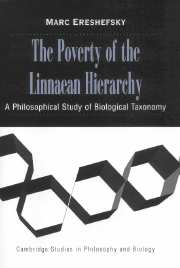2 - A Primer of Biological Taxonomy
Published online by Cambridge University Press: 16 July 2009
Summary
The previous chapter provided an introduction to the philosophy of classification. In upcoming chapters we examine how various issues in the philosophy of classification arise in biological taxonomy. But first we need a proper introduction to biological taxonomy. That is the job of this chapter.
Before the schools of biological taxonomy are discussed, some terminology should be clarified. This book concerns itself with philosophical problems in biological taxonomy, but what is the difference between “taxonomy”and “classification”? And how are these distinguished from “systematics”? Let us start with the first term. According to Mayr (1969, 2), “[t]axonomy is the theory and practice of classifying organisms.” A school of biological taxonomy offers principles and techniques for constructing biological classifications. Those methods tell us how to classify organisms into taxa and how to classify taxa into more inclusive taxa (species into families, for instance). The term “classification” refers to the product of taxonomy. Using the methods of a particular school of taxonomy, biologists construct classifications of the organic world.
Systematics is a bit different. In this book, I follow Simpson's (1961, 7) description of biological systematics: “Systematics is the scientific study of the kinds and diversity of organisms and of any and all relationships among them.” Biological systematics does not provide methods for constructing classifications (that is the job of biological taxonomy); instead it studies how organisms and taxa are related in the natural world.
Information
- Type
- Chapter
- Information
- The Poverty of the Linnaean HierarchyA Philosophical Study of Biological Taxonomy, pp. 50 - 93Publisher: Cambridge University PressPrint publication year: 2000
